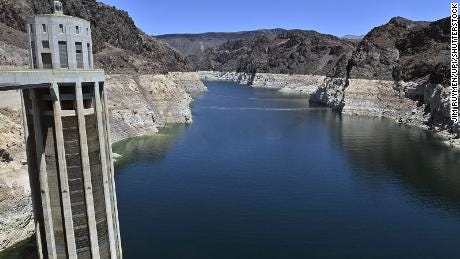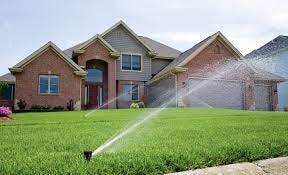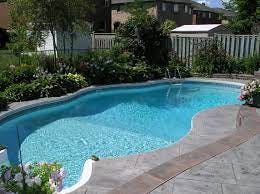The Colorado River, and the reservoirs it feeds, is running dry. Nearly 40 million Americans in seven states depend on it for drinking water, farming, and recreation. But since 2020, precipitation has been the lowest it’s been for some 1,200 years, according to climatologists.
Meanwhile, these Western states are seeing some of the fastest growth in the nation. This combination of reduced water supply and booming demand has reduced water levels on Lake Powell and Lake Mead to something like 20% of capacity. A recent episode of CBS’s 60 Minutes dramatized the situation. And the crises is predicted to only get worse.
Yet, out west, the swimming pools, lush green lawns, fountains, golf courses, and flood-irrigated farmlands are still standing. People are still relaxing with long showers or deep baths, and washing big loads of laundry - every day.
The day of reckoning is not far off, when Western citizens go to their taps for a drink, and nothing comes out.
This is the classic example of what happens when put politicians and bureaucrats in charge of a vital resource – in this case water. Using some twisted logic about how water is “too important” to be entrusted to profit-hungry businesses, we have instead declared water a “public good” and therefore is a job for government.
Exactly one hundred years ago, the Colorado River Compact was established. This agreement governed water rights among the seven states that depend on the river. It involved federal laws, treaties, court decisions, and regulatory guidelines. It was actually a workable solution back in the days when precipitation was much higher and the population was much lower. But now that that situation has changed, the cracks in the system are showing.
The end result is that fresh water is terribly underpriced. Thus, from the consumers perspective, there is no built-in incentive to conserve. Break out the lush lawns and the swimming pools! Then municipalities must institute bans and arbitrary limits on these luxuries. A far better approach would simply be to let the price of water rise naturally, and if someone wants to fork out a fortune to fill their pool, well, that’s their choice.
The biggest consumer of water, however, is not residences, pools, or municipalities, but rather agriculture. This industry uses about 70% of water nation-wide. One must question the wisdom of growing water-intensive crops in the deserts of California and Arizona. Yes we consumers rely on this produce, but wouldn’t it make more sense to grow these vast quantities of fruits and vegetables in a wetter climate?
Meanwhile, there are far more water-efficient techniques for growing crops, such as indoor farming. The startup cost for an indoor farm is considerably higher than that for its outdoor cousin, but if the price of water is high enough, it becomes economically advantageous.
From the producers’ perspective, there are better alternatives for providing water to west-coast cities such as Los Angeles. Presently, most of the water consumed there is provided via a system of aqueducts and canals that pipe in water from rivers such as the Colorado. But in case no one noticed, there is a huge ocean nearby. Desalination facilities are expensive to build and operate, but if the price of water is high enough, then it becomes feasible.
To fix the problem, governmental bodies such as the River Compact must be abolished. Private property rights must be identified, established, and protected. The government-created monopolies known as municipal water departments must be replaced by for-profit businesses, with full rights to buy, sell, and trade commodities such as water without price controls and other bureaucratic constraints.
Free enterprise has always been the most efficient system for providing consumers with the things they need and want. It’s even better than bureaucratic socialism! We need to quit making crazy exceptions, especially for vital resources such as water.










As a native Arizonan I am not going to pretend that I do not find the amount of growth we are experienceing troublesome when it comes to the problem of water supply. However this solution sound suspiciously like the lefts climate agenda, "raise the price of gas so high EV's look cost effective" strategy.
It also discounts measures that are already being taken by municipalities in the Valley to reduce water consumption. Many cities have been requiring desert landscaping for front yards, or turf instead of grass. I know Glendale had a program that would rebate you for the cost of replacing grass with desert landscaping. I am not sure if it is still active but we took advantage of it years ago.
I am not familiar with what Nevada and California are doing, but I highly doubt they are as efficient in regulating the water supply as Arizona is.
Thank you for your article, most interesting; i empathize especially having lived_in/seen the disaster in the Colorado Front range.
But allow 2 corrections, if you will:
1) California (Central Valley) is hardly desert (considered by many to be the most productive valley worldwide, most certainly the US) and with 18k mi. is far more suitable/lush then any other space for its produce, the canal transport system, and its overall abundance.
2)The western states euphemism misrepresents all that is the WEST. Certianly the states you mention in the Southwest (and some central west) but the Northwest and the Rocky Mountains have no such fear, not suffering under the Colorado compact, while our 'relatively southern neighbors' with their massive populations may see that day, its not foreseeable for us. (though things change)
No argument that dunsel agencies can and will screw up public services in a heartbeat.